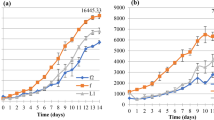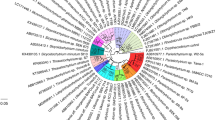Abstract
An isolation program targeting Thraustochytrids (marine fungoid protists) from 19 different Atlantic Canadian locations was performed. Sixty-eight isolates were screened for biomass, total fatty acid (TFA), eicosapentaenoic acid (EPA), and docosahexaenoic acid (DHA) content. Analysis of fatty acid methyl ester results discerned four distinctive clusters based on fatty acid profiles, with biomass ranging from 0.1 to 2.3 g L−1, and lipid, EPA, and DHA contents ranging from 27.1 to 321.14, 2.97 to 21.25, and 5.18 to 83.63 mg g−1 biomass, respectively. ONC-T18, was subsequently chosen for further manipulations. Identified using 18S rRNA gene sequencing techniques as a Thraustochytrium sp., most closely related to Thraustochytrium striatum T91-6, ONC-T18 produced up to 28.0 g L−1 biomass, 81.7% TFA, 31.4% (w/w biomass) DHA, and 4.6 g L−1 DHA under optimal fermentation conditions. Furthermore, this strain was found to produce the carotenoids and xanthophylls astaxanthin, zeaxanthin, canthaxanthin, echinenone, and β-carotene. Given this strain’s impressive productivity when compared to commercial strains, such as Schizochytrium sp. SR21 (which has only 50% TFA), coupled with its ability to grow at economical nitrogen and very low salt concentrations (2 g L−1), ONC-T18 is seen as an ideal candidate for both scale-up and commercialization.






Similar content being viewed by others
References
Aki T, Hachida K, Yoshinaga M, Katai Y, Yamasaki T, Kawamoto S, Kakizono T, Maoka T, Shigeta S, Suzuki O, Ono K (2003) Thraustochytrids as a potential source of carotenoids. J Am Oil Chem Soc 80:789–794
Bajpai PK, Bajpai P, Ward OP (1991) Optimization of production of docosahexaenoic acid (DHA) by Thraustochytrium aureum ATCC 34304. J Am Oil Chem Soc 68:509–514
Barclay WR, Meager KM, Abril JR (1994) Heterotrophic production of long chain omega-3 fatty acids utilizing algae and algae-like microorganisms. J Appl Phycol 6:123–129
Benson DA, Karsch-Mizrachi I, Lipman DJ, Ostell J, Wheeler DL (2005) GenBank. Nucleic Acids Res 33:D34–38
Bowles RD, Hunt AE, Bremer GB, Duchars MG, Eaton RA (1999) Long-chain n-3 polyunsaturated fatty acid production by members of the marine protistan group the Thraustochytrids: screening of isolates and optimisation of docosahexaenoic acid production. J Biotechnol 70:193–202
Bremer G (2000) Isolation and culture of Thraustochytrids. In: Hyde K, Pointing S (eds) Marine mycology — a practical approach. Fungal Diversity Press, Hong Kong, pp 49–61
Burja AM, Radianingtyas H (2005) Marine microbial-derived nutraceutical biotechnology: an update. Food Sci Technol 19:14–16
Carmona ML, Naganuma T, Yamaoka Y (2003) Identification by HPLC-MS of carotenoids of the Thraustochytrium CHN-1 strain isolated from the Seto Inland Sea. Biosci Biotechnol Biochem 67:884–888
Ellenbogen BB, Aaronson S, Goldstein S, Belsky MM (1969) Polyunsaturated fatty acids of aquatic fungi: possible phylogenetic significance. Comp Biochem Physiol 29:805–811
Felsenstein J (1985) Confidence limits on phylogenies: an approach using the bootstrap. Evolution 39:783–791
Goldstein S (1963) Development and nutrition of new species of Thraustochytrium. Am J Bot 50:271–279
Honda D, Yokochi T, Nakahara T, Raghukumar S, Nakagiri A, Schaumann K, Higashihara T (1999) Molecular phylogeny of labyrinthulids and Thraustochytrids based on the sequencing of 18S Ribosomal RNA Gene. J Eukaryot Microbiol 46:637–647
Huang J, Aki T, Yokochi T, Nakahara T, Honda D, Kawamoto S, Shigeta S, Ono K, Suzuki O (2003) Grouping newly isolate docosahexaenoic acid-producing Thraustochytrids based on their polyunsaturated fatty acid profiles and comparative analysis of 18S rRNA genes. Mar Biotechnol (NY) 5:450–457
Ilda I, Nakahara T, Yokochi T, Kamisaka Y, Yagi H, Yamaoka M, Suzuki O (1996) Improvement of docosahexaenoic acid production in a culture of Thraustochytrium aureum by medium optimization. J Ferment Bioeng 81:76–78
Kamlangdee N, Fan KW (2003) Polyunsaturated fatty acids production by Schizochytrium sp. isolated from mangrove. J Sci Technol 25:643–650
Leander CA, Porter D (2001) The Labyrinthulomycota is comprised of three distinct lineages. Mycologia 93:459–464
Lewis T, Nichols PD, McMeekin TA (2000) Evaluation of extraction methods for recovery of fatty acids from lipid-producing microheterotrophs. J Microbiol Methods 43:107–116
Li ZY, Ward OP (1994) Production of docosahexaenoic acid by Thraustochytrium roseum. J Ind Microbiol 13:238–241
Mo C, Douek J, Rinkevich B (2002) Development of a PCR strategy for Thraustochytrid identification based on 18S rDNA sequence. Mar Biol 140:883–889
Nakahara T, Yokochi T, Higashihara T, Tanaka S, Yaguchi T, Honda D (1996) Production of docosahexaenoic and docosapentaenoic acids by Schizochytrium sp. isolated from Yap Islands. J Am Oil Chem Soc 73:1421–1426
Raghukumar S (2002) Ecology of the marine protists, the Labyrinthulomycetes (Thraustochytrids and Labyrinthulids). Eur J Protistol 38:127–145
Saitou N, Nei M (1987) The neighbor-joining method: a new method for reconstructing phylogenetic trees. Mol Biol Evol 4:406–425
Sijtsma L, Springer J, Moesters PAEP, de Swaaf ME, Eggink G (1998) Recent advances in fatty acid synthesis in oleaginous yeasts and microalgae. Recent Res Dev Microbiol 2:219–232
Valadon LRG (1976) Carotenoids as additional taxonomic characters in fungi: a review. Trans Br Mycol Soc 67:1–15
Yaguchi T, Tanaka S, Yokochi T, Nakahara T, Higashihara T (1997) Production of high yields of docosahexaenoic acid by Schizochytrium sp. strain SR21. J Am Oil Chem Soc 74:1431–1434
Yokochi T, Honda D, Higashihara T, Nakahara T (1998) Optimization of docosahexaenoic acid production by Schizochytrium limacinum SR21. Appl Microbiol Biotechnol 49:72–76
Yokochi T, Nakahara T, Higashihara T, Tanaka S, Yaguchi T (2003) Microorganisms capable of producing highly unsaturated fatty acids and process for producing highly unsaturated fatty acids by using the microorganisms. US Patent 6,582,941
Author information
Authors and Affiliations
Corresponding author
Rights and permissions
About this article
Cite this article
Burja, A.M., Radianingtyas, H., Windust, A. et al. Isolation and characterization of polyunsaturated fatty acid producing Thraustochytrium species: screening of strains and optimization of omega-3 production. Appl Microbiol Biotechnol 72, 1161–1169 (2006). https://doi.org/10.1007/s00253-006-0419-1
Received:
Revised:
Accepted:
Published:
Issue Date:
DOI: https://doi.org/10.1007/s00253-006-0419-1




